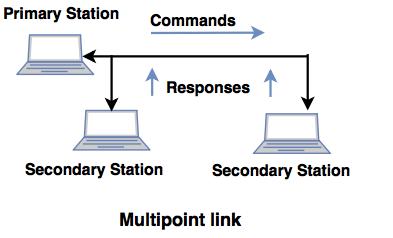High Level Data Link Control (HDLC)
- HDLC protocol is an international standard defined by ICO, which is used on point-to-point and multipoint data links.
- It supports full duplex, transparent mode operation.
HDLC defines three types of stations to support a variety of applications:
1. Primary Station- It is responsible for controlling operation of the link.
- Frames issued by the primary station are called as command.
2. Secondary station- It is operated under the control of primary station.
- Frames issued by the secondary station are called as responses.
- The primary station maintains separate logical links with each secondary station.
3. Combined station- It has mixed features of primary station and secondary station.
- A combined station can issue both command and responses.
The stations can be configured in different network configurations as
i) Point-to-point link with one primary station and one secondary station.
The frames sent from primary station to secondary station are called as
commands and those frames sent from the secondary to primary station are known as
responses.
 ii) Multipoint link with single primary station and multiple secondary stations.
ii) Multipoint link with single primary station and multiple secondary stations.
In this configuration, the single primary station is known as unbalanced configuration. Unbalanced configuration supports full duplex transmission
as well as half duplex transmission.
 iii) Point-to-Point link with two primary stations and two secondary stations.
iii) Point-to-Point link with two primary stations and two secondary stations.
In this type of configuration, there are two primary stations called as
balanced configuration. Balanced configuration supports full duplex and half duplex transmission.

Operational Mode of HDLC
HDLC has two data transfer modes:
1. Normal Response Mode (NRM)- This mode is used in unbalanced configurations.
- This link is configured by using one primary station and multiple secondary stations, in which the primary station can send commands while secondary station can only respond.
- The NRM is used in configuration of point-to-point as well as multipoint links.
2. Asynchronous Balanced Mode(ABM)- In this mode, configuration is balanced. The link is point-to-point and each station can operate as a primary station and secondary station.
Point-to-Point Protocol (PPP)
It is used for point-to-point transfer of data.
Services provided by the point-to-point protocol are:
1. Formatting of frames.
2. Negotiations between devices to establish the link.
3. Authentication of devices.
4. Encapsulation of data in data link frame.
Frame format of point-to-point protocol
Point-to-Point protocol frame format is similar to HDLC, shown in the following diagram.
 1. Flag
1. Flag
It identifies the boundaries of the PPP frames. Each frame starts and ends with flag field. This field has a size of 1byte.
2. Address
This field denotes the address of the destination with size of 1 byte (8bits).
If address field consists of all '1', i.e. 1111111, this indicates that all stations can accept the frames.
3. Control
Control field is set to 11000000, which indicates that frame does not contain sequence numbers and there is no flow or error control.
4. Protocol
It defines the information of the data field and it may be 1 or 2 byte long.
5. Data
This field contains the actual data which is to be transmitted.
6. Frame check sequence (FCS)
This field is 2 or 4 byte long and contains a CRC code used to check the length of all fields in frame. This field provides a basic protection against error in the transmission.



